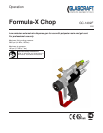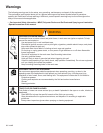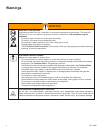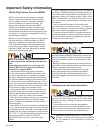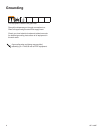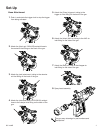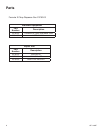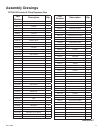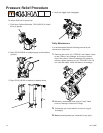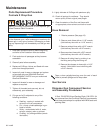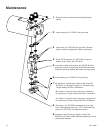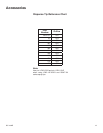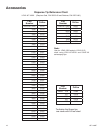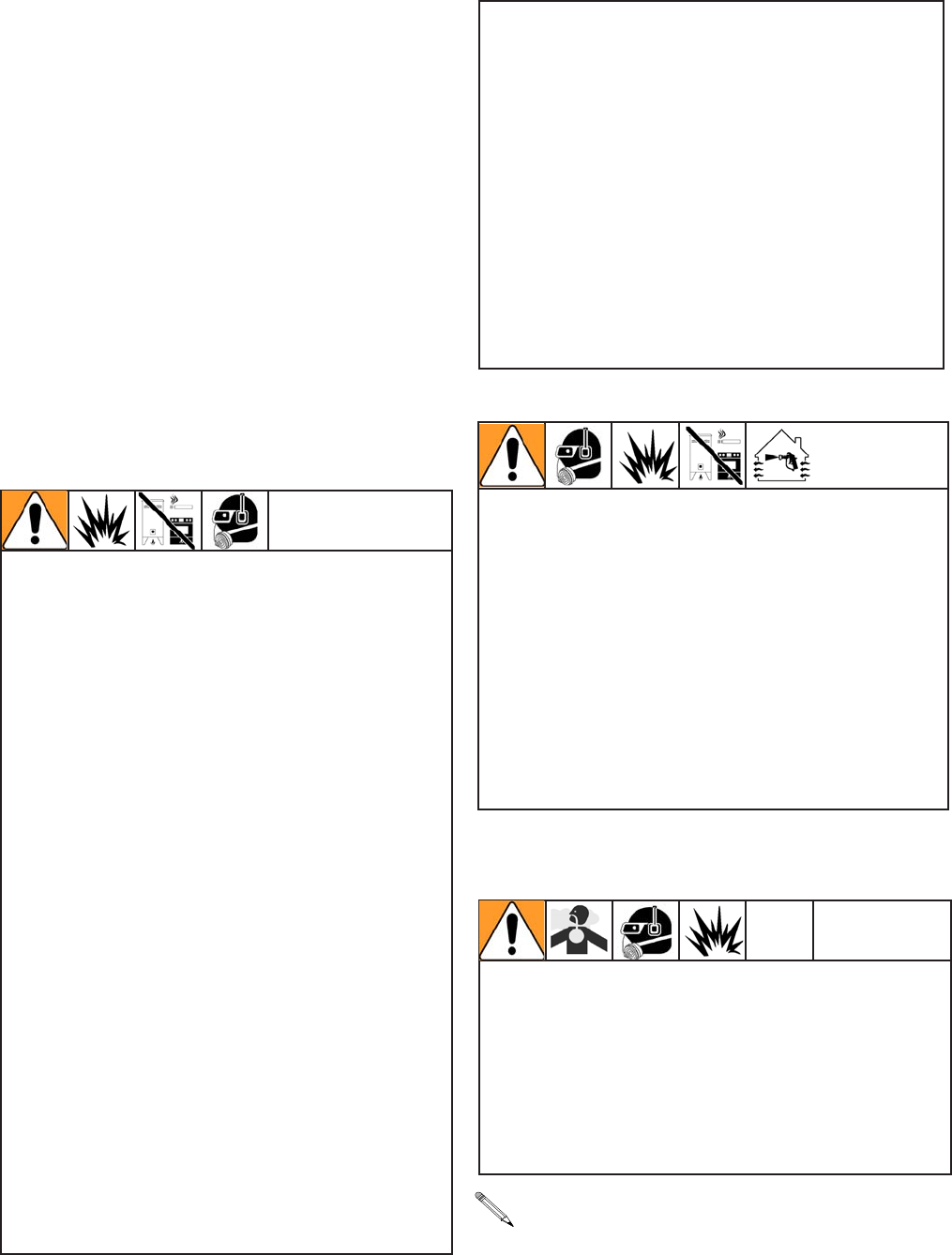
5GC-1402E
Important Safety Information
Methyl Ethyl Ketone Peroxide (MEKP)
MEKP is among the more hazardous materials
found in commercial channels. Proper handling
of the “unstable (reactive)” chemicals presents a
denite challenge to the plastics industry. The
highly reactive property which makes MEKP
valuable to the plastics industry in producing the
curing reaction of polyester resins and gel-coats
also produces the hazards which require great care
and caution in its storage, transportation, handling,
processing and disposal.
Workers must be thoroughly informed of the hazards
that may result from improper handling of MEKP,
especially in regards to contamination and heat.
They must be thoroughly instructed regarding the
proper action to be taken in the storage, use and
disposal of MEKP and other hazardous materials
used in the laminating operation.
Polyester Resins and Gel-Coats
Spraying and Lamination Operations
GlasCraft recommends that you consult OSHA
Sections 1910.94, 1910.106, 1910.107 and NFPA
No. 33, Chapter 16,17, and NFPA No. 91 for further
guidance.
Spraying materials containing polyester resin and
gel-coats creates potentially harmful mist, vapors and
atomized particulates. Prevent inhalation by providing
sufcient ventilation and the use of respirators in the
work area.
Read the material manufacturer’s warnings and ma-
terial MSDS to know specic hazards and precautions
related to polyester resins and gel-coats.
To prevent contact with polyester resins and gel-
coats, appropriate personal protective equipment,
including chemically impermeable gloves, boots,
aprons and goggles are required for everyone in the
work area.
Isocyanate Conditions
Rev. G 6/17/2008 21
Isocyanate Conditions
Material Self-ignition
Moisture Sensitivity of
Isocyanites
Isocyanites (ISO) are catalysts used in two component
foam and polyurea coatings. ISO will react with moisture
(such as humidity) to form small, hard, abrasive crystals,
which become suspended in the fluid. Eventually a film
will form on the surface and the ISO will begin to gel,
increasing in viscosity. If used, this partially cured ISO
will reduce performance and the life of all wetted parts.
To prevent exposing ISO to moisture:
• Always use a sealed container with a desiccant
dryer in the vent, or a nitrogen atmosphere. Never
store ISO in an open container.
• Keep the ISO lube pump reservoir (if installed) filled
with Graco Throat Seal Liquid (TSL), Part 206995.
The lubricant creates a barrier between the ISO and
the atmosphere.
• Use moisture-proof hoses specifically designed for
ISO, such as those supplied with your system.
• Never use reclaimed solvents, which may contain
moisture. Always keep solvent containers closed
when not in use.
• Never use solvent on one side if it has been contam-
inated from the other side.
• Always lubricate threaded parts with ISO pump oil
or grease when reassembling.
Keep Components A and
B Separate
Foam Resins with 245 fa
Blowing Agents
Some foam blowing agents will froth at temperatures
above 90°F (33°C) when not under pressure, especially
if agitated. To reduce frothing, minimize preheating in a
circulation system.
Spraying materials containing isocyanates creates
potentially harmful mists, vapors, and atomized partic-
ulates.
Read material manufacturer’s warnings and material
MSDS to know specific hazards and precautions
related to isocyanates.
Prevent inhalation of isocyanate mists, vapors, and
atomized particulates by providing sufficient ventila-
tion in the work area. If sufficient ventilation is not
available, a supplied-air respirator is required for
everyone in the work area.
To prevent contact with isocyanates, appropriate per-
sonal protective equipment, including chemically
impermeable gloves, boots, aprons, and goggles, is
also required for everyone in the work area.
Some materials may become self-igniting if applied
too thickly. Read material manufacturer’s warnings
and material MSDS.
The amount of film formation and rate of crystalli-
zation varies depending on the blend of ISO, the
humidity, and the temperature.
NOTICE
To prevent cross-contamination of the equipment’s
wetted parts, never interchange component A (isocy-
anate) and component B (resin) parts.
MEKP is ammable and potentially explosive,
as well as potentially damaging to the eyes and
skin.
Read material manufacturer’s warnings and
material MSDS to know specic hazards and
precautions related to MEKP.
Contaminated MEKP can become explosive.
Prevent contamination of MEKP with other materi-
als, which includes, but is not limited to polyester
overspray, polymerization accelerators and promot-
ers, and non-stainless metals. Even small amounts
of contaminates can make MEKP explosive. This re-
action may start slowly, and gradually build-up heat,
which can accelerate until re or an explosion result.
This process can take from seconds to days.
Heat applied to MEKP, or heat build-up from con-
tamination reactions can cause it to reach what is
called its Self-Accelerating Decompisition Tempera-
ture (SADT), which can cause re or explosion.
Spills should be promptly removed, so no residues
remain. Spillage can heat up to the point of self-
ignition. Dispose in accordance with manufacture’s
recommendation.
Store MEKP in a cool, dry and well-ventilated area
in the original containers away from direct sunlight
and away from other chemicals. It is strongly recom-
mended that the storage temperature remain below
86° F (30° C). Heat will increase the potential for ex-
plosive decomposition. Refer to NFPA 432.
Keep MEKP away from heat, sparks and open
ames.
Remove all accumulations of overspray, FRP sand-
ings, etc. from the building as they occur. If this waste
is allowed to build up, spillage of catalyst is more likely
to start a re.
If cleaning solvents are required, read material
manufacture’s warnings and material MSDS to know
specic hazards and precautions. (GlasCraft recom-
mends that clean-up solvents be nonammable.)
Current catalysts are premixed and do not require
any diluents. GlasCraft strongly recommends that dilu-
ents not be used. Diluants add to the possibility of con-
taminates entering the catalyst system. Never dilute
MEKP with acetone or any solvent since this can pro-
duce an extremely shock-sensitive compound which
can explode.
Use only original equipment or equivalent parts
from GlasCraft in the catalyst system (i.e.: hoses, t-
tings, etc.) because a hazardous chemical reaction
may result between substituted parts and MEKP.
To prevent contact with MEKP, appropriate personal
protective equipment, including chemically imperme-
able gloves, boots, aprons and goggles are required
for everyone in the work area.



